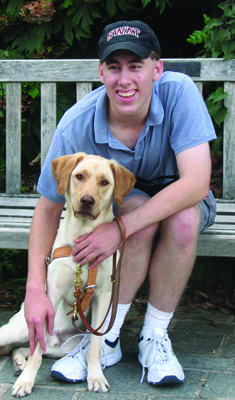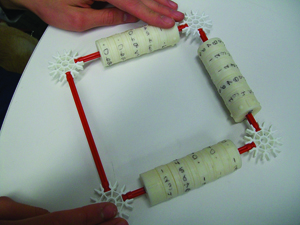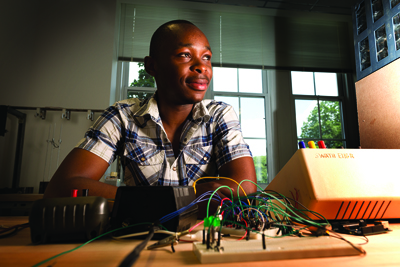Community Vision
Budding engineer Hayden Dahmm ’15 benefits from the help of his professor and fellow students

Hayden Dahmm and Fathom are inseparable. They share a single in Parrish Hall. Fathom has pushed his bed under Dahmm’s, making them “bunkmates,” says Dahmm. With Fathom leading the way, Dahmm is now as intrepid a navigator of campus pathways as he is of the road to an engineering degree. Photo courtesy of Hayden Dahmm
Aspiring environmental engineer Hayden Dahmm ’15 is a personable young man with a ready laugh and a clear, melodious voice. Blessed with an enviable memory and ace mental computing skills, he’s hardly different from any other Swarthmore student—except for one thing. Dahmm is blind.
Born more than three months premature, direly underweight and with underdeveloped bodies, Dahmm and his twin brother Ethan spent weeks in incubators, being fed pure oxygen under bright lights. They developed retinopathy of prematurity (ROP)—partial detachment of the retina, which left Hayden with severely diminished vision. “I’m extremely fortunate, though,” he says, explaining that his brother was left profoundly blind and suffered a brain hemorrhage, leading to epilepsy and cerebral palsy. “He’s in a wheelchair and doesn’t have extensive verbal skills,” Dahmm says. “So my condition is very minor. Ethan is an incredible brother with a great sense of humor. He loves poetry and music.”
Dahmm’s sight deteriorated further with the onset of puberty—the typical progression of ROP. By the time he came to Swarthmore in 2011 as a McCabe Scholar, he had lost all functional vision and moved around with a white cane.
Despite the fact that engineering courses are both intensely rigorous and, for the most part, very visual, Dahmm was undeterred and signed up for Engineering Methodology, an introductory course taught by Carr Everbach.
Everbach had learned just a few days before classes began that there’d be a blind student in the course. “I was shocked,” he says. “We’ve had blind students on campus before, but not in engineering. And the course involves working in a machine shop, using spinning, rotating blades; fabricating a robot, assembling it, programming it, using computer screens.” Furthermore, much of the theoretical part of the class was taught using PowerPoint presentations showing graphs and pictures. Hayden quickly put his professor’s mind at rest.
“He’s so personable and easygoing—and really smart,” Everbach says. Dahmm’s capacity to absorb information aurally allowed Everbach to explain the complex concepts he’d drawn on the blackboard, even describing graphs or detailed 3-D drawings. “Hayden listened, then asked questions that showed he understood,” Everbach says, adding that other students in the class also appreciated having the explanations repeated.
Dahmm was less anxious than his teacher about his ability to keep up in class.

For Dahmm’s electronic circuits course, rotary plastic elements resembling Tinker Toy wheels were produced using the College’s 3-D printer and provided with Braille numbers. By stringing them along toy K’nex rods and connecting the rods by joiners, Dahmm could assemble physical, tactile models of resistors, capacitors, and inductors equivalent to diagrams drawn on the chalkboard. He adapted the tools for a later course in mechanics. Photo by Carr Everbach
“We built robots that played ‘tag.’ It was a lot of fun, mainly with the aim of getting an idea of what engineering is and whether it was what we wanted to do,” he says.
In his second semester, Dahmm enrolled in Mechanics. “It’s all diagrams and equations on the chalkboard, and problem sets,” says Everbach. “Having learned from the first semester, I brought tangible examples of as many of the things I talked about as possible. I passed them around, particularly to Hayden, but to the other students as well.”
Three scribes helped Dahmm in class. Two of them read the homework problem sets and described the diagrams to him. Dahmm digested the information they gave him, then dictated to a third student which diagrams and equations he would like to submit as his solutions.
“They weren’t doing any of the math. I was doing all that, but it was laborious,” Dahmm says. They used Legos to reproduce in 3-D the diagrams that were being described on the page.
Summer 2012 brought more support for Dahmm. Everbach helped him apply for and obtain a Richard Rubin Fellowship grant for disadvantaged students, enabling Everbach to become Dahmm’s mentor over the summer. And Dahmm was partnered with Fathom, a Seeing Eye dog. “Fathom is not merely my guide. He’s my best friend, a brother, a son, a constant companion and confidant all in one.”
With a course on electrical circuit analysis coming up in the fall, Everbach worried about Dahmm’s inability to see the board as well as being unable to have a sense of voltage, currents, electrons, and other non-concrete concepts.
“The course is all about drawings—resistors, capacitors, inductors—on the blackboard, and I wasn’t teaching that one,” Everbach says.

Tinashe “Harry” Mubvuma ’14, one of the three students who acted as readers and scribes for Dahmm, was inspired by his work and spent the summer working on the development of a refreshable Braille calculator and possibly a text-to-Braille translator. He was funded by a grant from the Halpern Family Foundation Engineering Design Fund, supporting work by students on interdisciplinary projects with socially relevant purposes, which include design engineering principles as well as aesthetics and client needs. Photo by Laurence Kesterson
With funding from the Lang Center for Civic and Social Responsibility, Everbach—with his teenage son Ian, Ian’s friend Nick Cheung, and some Swarthmore students, including Dahmm—spent summer 2012 inventing tools for Dahmm to use in his future courses. Using a 3-D printer and a K’nex toy construction kit, they developed models, equipped with Braille notation, that represented resistors, capacitors, inductors, voltage, and current sources. Using the models, Dahmm could visualize the diagrams drawn on the blackboard. He was able to reconfigure and use the tools in a later mechanics course.
“I thought this was clever, but I didn’t realize how clever until I started to use the pieces in my classes,” Dahmm says. “I don’t know how I would have gotten through without them.” He cites Ian Everbach in particular as the 3-D printing expert who produced some of the pieces.
Everbach and Dahmm also began to explore the possibility of data sonification as a tool. In collaboration with engineers at Drexel University and researchers at the Haptics Lab at the University of Pennsylvania, they created a gadget that enables numerical data to be converted to a series of sounds, which Dahmm can listen to and translate back into data. “It was a terrific summer,” he says.
So was this past summer, Dahmm adds. Funded by the National Science Foundation, he spent 10 weeks at Purdue University taking on The Grand Challenges of Engineering—a program focused on environmental-engineering problems. Dahmm investigated methods of carbon sequestration and its uses.
Now back for his junior year, Dahmm will be able to put what he learned in Indiana to good use as a member of Swarthmore’s Sustainability Committee.
 Email This Page
Email This Page
October 18th, 2013 12:36 pm
Simply amazing!
A Proud Swarthmore Mom